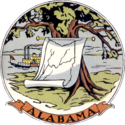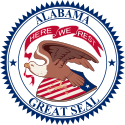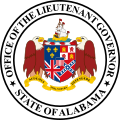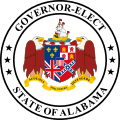
The coat of arms of the Philippines features the eight-rayed sun of the Philippines with each ray representing the eight provinces which were placed under martial law by Governor-General Ramón Blanco Sr. during the Philippine Revolution, and the three five-pointed stars representing the three major island groups of Luzon, the Visayas, and Mindanao.

The coat of arms of the state of New Jersey includes:

The flag of Delaware consists of a buff-colored diamond on a field of colonial blue, with the coat of arms of the state of Delaware inside the diamond. Below the diamond, the date December 7, 1787, declares the day on which Delaware became the first state to ratify the United States Constitution. The colors of the flag reflect the colors of the uniform of General George Washington.

The coat of arms of Poland is a white, crowned eagle with a golden beak and talons, on a red background.

The seal of the president of the United States is used to mark correspondence from the president of the United States to the U.S. Congress, and is also used as a symbol of the presidency itself. The central design, based on the Great Seal of the United States, is the official coat of arms of the U.S. presidency and also appears on the presidential flag.

The Great Seal of the State of Hawaii was designated officially by Act 272 of the 1959 Territorial Legislature and is based on the territorial seal. Modifications to the territorial seal included the use of the words "State of Hawaii" at the top and "1959" within the circle. Provisions for a seal for the state of Hawaii were enacted by the Territorial Legislature and approved by Governor William F. Quinn on June 8, 1959. The passage of the Admission Act in 1959, admitted Hawaii as the 50th State of the United States of America on August 21, 1959.

The Seal of the Commonwealth of Virginia is the official seal of the Commonwealth of Virginia, a U.S. state. The state flag of Virginia consists of the obverse of the seal against a blue background. A state flag was first adopted at the beginning of the American Civil War in April 1861, readopted in 1912, and standardized by the General Assembly in February 1950. The standing allegorical female figure of virtue is shown having vanquished tyranny, symbolized by a fallen king at her feet. She has an exposed breast in the manner of classical depictions of Amazons, making this the only state flag in the U.S. depicting a form of nudity. The motto Sic semper tyrannis means "Thus always to tyrants." The flag may be decorated with a white fringe along the fly edge; this is usually done when the flag is displayed indoors.

The Great Seal of the State of Michigan depicts the coat of arms of the U.S. state of Michigan on a light blue field. On the dark blue shield the Sun rises over a lake and peninsula, a man holding a long gun with a raised hand represents peace and the ability to defend his rights. The elk and moose are symbols of Michigan, while the bald eagle represents the United States.

The Great Seal of the State of Utah was adopted on April 3, 1896, at the first regular session of the Legislature. The original seal was designed by Harry Edwards & C. M. Jackson and cost $65.00, equivalent to $2,286 in 2022. The great seal is described in Utah Code Annotated, 1953, Volume 7a, section 67-2-9 as follows:
"The Great Seal of the State of Utah shall be two and one-half inches in diameter, and of the following device; the center a shield and perched thereon an American Eagle with outstretching wings; the top of the shield pierced by six arrows crosswise; under the arrows the motto "INDUSTRY"; beneath the motto a beehive, on either side growing sego lilies; below the figures "1847"; on each side of the shield an American Flag.; encircling all, near the outer edge of the seal, beginning at the lower left-hand portion, the words, "THE GREAT SEAL OF THE STATE OF UTAH", with the figures "1896" at the base."

The Great Seal of the State of New Mexico is the official seal of the U.S. state of New Mexico. It is enshrined in Article V, Section 10, of the New Mexico State Constitution, which requires a state emblem to be kept by the secretary of state for official documents and other expressions of statehood. Rooted in the official seal of the New Mexico Territory established in 1851, it was adopted in 1913, one year after New Mexico was admitted as the 47th state.

The Seal of the State of Texas was adopted through the 1845 Texas Constitution, and was based on the seal of the Republic of Texas, which dates from January 25, 1839.

Audemus jura nostra defendere — Latin for "We Dare Defend Our Rights" or "We Dare Maintain Our Rights" — is the state motto of Alabama and is depicted on the official Coat of arms of Alabama. The current coat of arms was created in 1923 at the request of state historian and director of the Alabama Department of Archives and History, Marie Bankhead Owen. It was not officially adopted until March 14, 1939. The motto itself is emblazoned on a golden band across the bottom of the coat of arms. The escutcheon of the coat of arms is quartered into the flags of the Kingdom of France, the Crown of Castile, the United Kingdom of Great Britain and Ireland, and the Confederate States of America, with a central overlay of the shield of the United States. Bald eagles serve as supporters to either side of the escutcheon. All is surmounted by a crimson and white torse and the Baldine, the sailing ship that Iberville and Bienville arrived in prior to the settlement of the colony of Mobile.

The Great Seal of the State of Mississippi was adopted in 2014, replacing a previous version that had been used since the 19th century.

The Great Seal of the State of Ohio is the official insignia of the U.S. state of Ohio. All governmental offices, agencies, and courts in Ohio use variations of the state seal. Its primary feature is a circular coat of arms that depicts a sunrise in Chillicothe, Ohio's first capital, along with symbols of the state's origins. The seal sometimes appears with the state motto, "With God, All Things Are Possible".

The Great Seal of the Commonwealth of Pennsylvania is the state seal for the Commonwealth of Pennsylvania. According to the state's website, the seal was authorized by the Pennsylvania General Assembly in 1791, and is "a symbol of authenticity which verifies that proclamations, commissions and other papers of state are legal and official."

The coat of arms of Alabama depicts a shield upon which is carried the symbols of the five states which have at various times held sovereignty over a part or the whole of what is now Alabama. These are the ancient coat of arms of France, the ancient coat of arms of Crown of Castile for Spain, the modern Union Jack of the United Kingdom and the battle flag of the Confederate States. On an escutcheon of pretence is borne the shield of the United States. The crest of the coat represents a ship which brought the French colonists who established the first permanent European settlements in the territory. Below is the state motto: Audemus jura nostra defendere, meaning "We dare defend our rights."

The flag of Wisconsin is the official flag of the U.S. state of Wisconsin. The flag was first adopted in 1863, and was modified in 1979. It is a blue flag charged with the state coat of arms of Wisconsin.

The seal of the vice president of the United States is used to mark correspondence from the U.S. vice president to other members of government, and is also used as a symbol of the vice presidency. The central design, directly based on the seal of the president of the United States, is the official coat of arms of the U.S. vice presidency and also appears on the vice presidential flag.
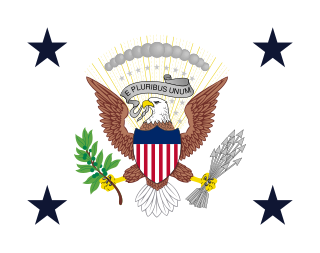
The flag of the vice president of the United States consists of the U.S. vice presidential coat of arms on a white background, with four dark blue stars in the corners. A version of the flag is kept in the vice president's office, is sometimes displayed by the vice president in official photos, and is flown on the vice president's motorcade.

The coat of arms of Mississippi is an official symbol of the State of Mississippi.

